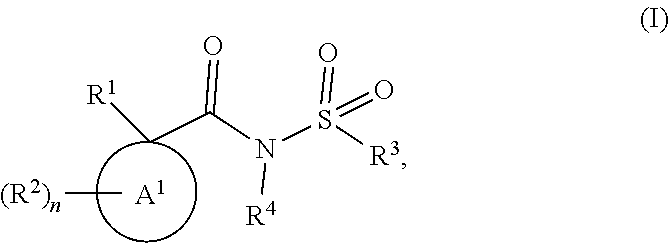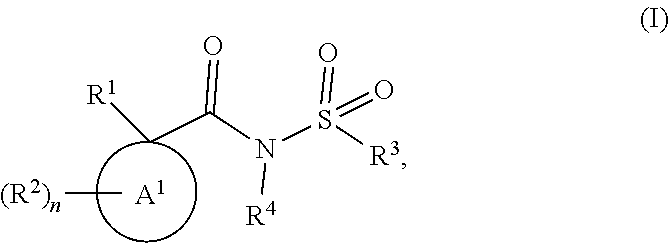Modulators of the cystic fibrosis transmembrane conductance regulator protein and methods of use
a transmembrane conductance regulator and protein technology, applied in the field of substitution of pyridine compounds, can solve the problems of reducing the apical anion secretion and disruption of cf patients with two copies of the cf associated gene suffering from the debilitating and fatal effects of cf, and reducing the apical anion secretion and fluid transport. disruption, the effect of reducing the apical anion
- Summary
- Abstract
- Description
- Claims
- Application Information
AI Technical Summary
Benefits of technology
Problems solved by technology
Method used
Image
Examples
example i-1
1-(5-bromo-2-methoxyphenyl)-N-(naphthalene-1-sulfonyl)cyclopropane-1-carboxamide
example i-1a
(1-(methoxycarbonyl)cyclopropyl)zinc(II) bromide
[2005]A 250-mL round bottom flask equipped with a magnetic stir bar under an atmosphere of nitrogen was treated with indium(III) chloride (0.323 g, 1.460 mmol) and acid washed zinc (7.32 g, 112 mmol) and then purged with nitrogen for several minutes. Tetrahydrofuran (70 mL) was added. Bromine (0.201 mL, 3.93 mmol) was added in a single portion resulting in a mild temperature increase. The mixture was warmed to 55° C. and stirred rapidly under a nitrogen atmosphere. In a separate flask, a solution of methyl 1-bromocyclopropanecarboxylate (6.54 mL, 56.2 mmol) in tetrahydrofuran (30 mL) was purged with nitrogen for 10 minutes. The mixture was added to the zinc slurry in a single portion via a cannula. The reaction was warmed at 55° C. for one hour. Using the titration method described in Knochel, P. Krasovskiy, A. Synthesis 2006-2006 (05), 0890-0891, the solution was determined to be 0.47 M and was used immediately in the next step.
example i-1b
methyl 1-(2-methoxyphenyl)cyclopropane-1-carboxylate
[2006]Into a 500 mL round bottom flask was added tris(dibenzylideneacetone)dipalladium(0) (0.086 g, 0.094 mmol), 1,2,3,4,5-pentaphenyl-1′-(di-tert-butylphosphino)ferrocene (0.133 g, 0.187 mmol) and tetrahydrofuran (144 mL) under nitrogen. 1-Bromo-2-methoxybenzene (2.313 mL, 18.71 mmol) was added and the resulting solution was treated with a 0.47 M solution of Example I-1A ((1-(methoxycarbonyl)cyclopropyl)zinc(II) bromide) (47.8 mL, 22.46 mmol) slowly over 10 minutes. The mixture was stirred at ambient temperature overnight. The reaction was quenched with saturated aqueous NH4Cl solution (50 mL) and extracted with ethyl acetate (200 mL). The organic layer was washed with saturated aqueous NH4Cl solution, dried over sodium sulfate, filtered, and concentrated. The crude residue was purified by chromatography on silica gel eluting with a gradient of 0-20% ethyl acetate in heptanes to provide the title compound. 1H NMR (400 MHz, CDCl3) ...
PUM
 Login to View More
Login to View More Abstract
Description
Claims
Application Information
 Login to View More
Login to View More - R&D
- Intellectual Property
- Life Sciences
- Materials
- Tech Scout
- Unparalleled Data Quality
- Higher Quality Content
- 60% Fewer Hallucinations
Browse by: Latest US Patents, China's latest patents, Technical Efficacy Thesaurus, Application Domain, Technology Topic, Popular Technical Reports.
© 2025 PatSnap. All rights reserved.Legal|Privacy policy|Modern Slavery Act Transparency Statement|Sitemap|About US| Contact US: help@patsnap.com



